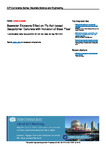Seawater Exposure Effect on Fly Ash based Geopolymer Concrete with Inclusion of Steel Fiber
| dc.contributor.author | Yahya, Z | |
| dc.contributor.author | Bakri Abdullah, MMA | |
| dc.contributor.author | Jing, LY | |
| dc.contributor.author | Li, Long-yuan | |
| dc.contributor.author | Razak, RA | |
| dc.date.accessioned | 2021-11-05T13:13:57Z | |
| dc.date.available | 2021-11-05T13:13:57Z | |
| dc.date.issued | 2020-03-18 | |
| dc.identifier.issn | 1757-8981 | |
| dc.identifier.issn | 1757-899X | |
| dc.identifier.uri | http://hdl.handle.net/10026.1/18243 | |
| dc.description.abstract |
<jats:title>Abstract</jats:title> <jats:p>Concrete is widely used in construction offshore such as concrete floating bridges and sea tank. This research is providing an alternative construction material to replace ordinary Portland cement (OPC) concrete known as geopolymer. The geopolymer concrete was produced by mixing fly ash with alkaline activator and 3% of steel fibre in order to improve the properties of fiber reinforced geopolymer concrete (FRGPC). The effects of aging period in term of strength, changes in weight and carbonation of FRGPC in seawater is investigated and compared with the fiber reinforced concrete (FROPC). The compressive strength obtained for FRGPC were higher than FROPC. The highest compressive strength obtained by FRGPC is 76.87 MPa at 28 days and 45.63 MPa at 28 days for FROPC concrete. The compressive strength was decreased as the period of immersing the concrete in seawater is increased. During the immersion process of both samples in seawater up to 120 days, the carbonation was not detected even though with the existence of steel fibres.</jats:p> | |
| dc.format.extent | 012013-012013 | |
| dc.language.iso | en | |
| dc.publisher | IOP Publishing | |
| dc.title | Seawater Exposure Effect on Fly Ash based Geopolymer Concrete with Inclusion of Steel Fiber | |
| dc.type | conference | |
| dc.type | Conference Proceeding | |
| plymouth.issue | 1 | |
| plymouth.volume | 743 | |
| plymouth.publication-status | Published | |
| plymouth.journal | IOP Conference Series: Materials Science and Engineering | |
| dc.identifier.doi | 10.1088/1757-899x/743/1/012013 | |
| plymouth.organisational-group | /Plymouth | |
| plymouth.organisational-group | /Plymouth/Faculty of Science and Engineering | |
| plymouth.organisational-group | /Plymouth/Faculty of Science and Engineering/School of Engineering, Computing and Mathematics | |
| plymouth.organisational-group | /Plymouth/REF 2021 Researchers by UoA | |
| plymouth.organisational-group | /Plymouth/REF 2021 Researchers by UoA/UoA12 Engineering | |
| plymouth.organisational-group | /Plymouth/Research Groups | |
| plymouth.organisational-group | /Plymouth/Research Groups/Marine Institute | |
| plymouth.organisational-group | /Plymouth/Users by role | |
| plymouth.organisational-group | /Plymouth/Users by role/Academics | |
| dcterms.dateAccepted | 2020-01-01 | |
| dc.rights.embargodate | 2021-11-6 | |
| dc.identifier.eissn | 1757-899X | |
| dc.rights.embargoperiod | Not known | |
| rioxxterms.versionofrecord | 10.1088/1757-899x/743/1/012013 | |
| rioxxterms.licenseref.uri | http://www.rioxx.net/licenses/all-rights-reserved | |
| rioxxterms.licenseref.startdate | 2020-03-18 | |
| rioxxterms.type | Conference Paper/Proceeding/Abstract |


